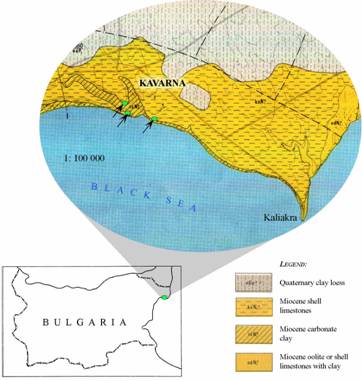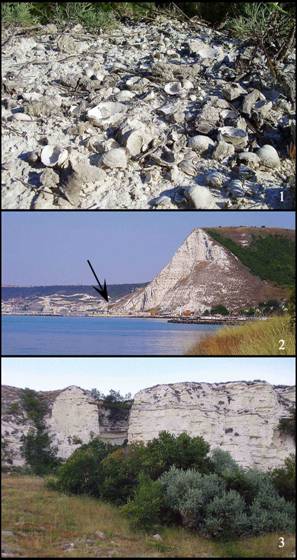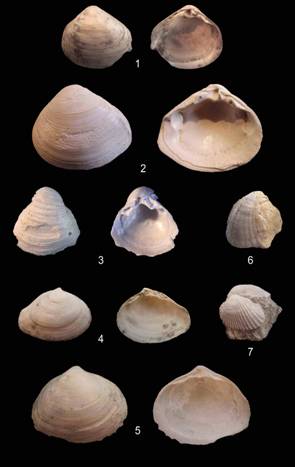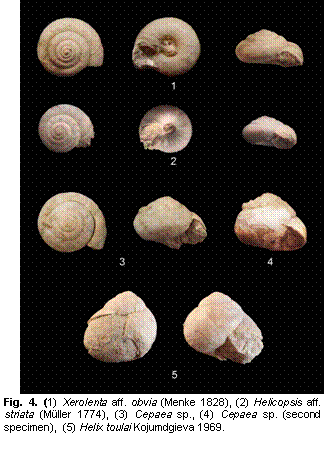|
During the late Miocene, 11-5.3 mya, the vegetation of Bulgaria was similar to that of present day tropical Africa, namely open grass savannah with scattered trees and shrubs. It was inhabited by mastodons, rhinos, large cats, antelopes, hipparions, giraffes and ostriches (Popov, 2004; Boev et al., 2008). Two large saline basins existed in the northern parts of the present Bulgaria - the pre-Carpathian basin in the north-west, and the Crimean-Caucasian basin in the north-east. A large number of fossil marine molluscs but only one land species have been registered in the deposits of the Sarmatian time interval (ca 13-12 mya) in northern Bulgaria (Yordanov, 1962; Kojumdgieva, 1969), but some upper Miocene limestone localities have not yet been investigated in detail. For the area of Kavarna town in north-east Bulgaria on the Black Sea coast, Kojumdgieva (1969) reported only a few species: Sarmatimactra vitaliana and Helix toulai from the Upper Sarmatian, and Cerastoderma pseudosemisulcatum, C. kolesnikovi, C. balcicense and Helix toulai from the Middle Sarmatian. In June 2007 and July 2008 we made additional finds of fossil mollusks from three localities in this area’s coastal zone (figs. 1 and 2). A total of 11 species of fossil molluscs were found – 7 species of marine mussels and 4 land gastropods (Table 1). The species were identified following Papp (1952), Kojumdgieva (1969) and Harzhauser & Binder (2004). Stratigraphic distribution of the molluscs was based on Kojumdgieva (1969). The material was deposited in the collection of the first author. One specimen of Sarmatimactra vitalaria still had remnants of coloration on the shell. In two specimens of Helix toulai four dark stripes were visible on the last whorl. The coloration, shell shape and size of H. toulai lead us to suppose that it could be evolutionary related to recent Helix albescens Rossmässler 1839 living nearby. It differs only by its completely closed umbilicus and narrower embryo whorls. All mollusc species found came from the Middle and/or Upper Sarmatian stage of the Upper Miocene (except for S. eichwaldi from the Lower Sarmatian). This is no doubt due to the large limestone formations belonging to this time interval at the Kavarna area (Kojumdgieva, 1969). |


|
Fig. 1. The three localities (arrowed) where late Miocene molluscs were collected. |

|
Fig. 2. Views of the three localities. Location 1 is a horizontal rock surface with a lot of Sarmatimactra vitaliana shells beneath an old Thracian Hill, north from the central beach of Kavarna. N 43° 25' 09.1'' E 28° 20' 53.6'. Location 2 is on the coastal area west from the central beach of Kavarna. N 43° 24' 45.1'' E 28° 20' 36.4'';Location 3 is below high cliffs on the coastal area east from the central beach of Kavarna. N 43° 24' 37.3'' E 28° 21' 51.9''. |
|
The presence of a land malacofauna indicates an ancient shore zone. Considering the ecological preferences of the snail species found this was probably occupied by open habitats with warm-loving, xeric grass and shrub vegetation. The species diversity and shell morphology of the sea mussels leads us to suggest a dominance of shallow and sandy marine habitats. The very thick shells of the mussels (especially S. vitaliana and S. bulgarica) support the thesis of Piller & Harzhauser (2005) that the salinity of the Sarmatian Sea was normal.
Literature cited Boev Z., N. Spassov, D. Kovachev, 2008. First remains of Fossil Ostriches (Aves: Struthioniformes: Struthionidae) from Bulgaria. Harzhauser M., H. Binder, 2004. Synopsis of the Late Miocene mollusc fauna of the classical sections of Richardhof and Eichkogel in the Vienna Basin. Arch. Molluskenkunde, 133(1/2): 1-57. Kojumdgieva E., 1969. The Fossils of Bulgaria: Sarmat, Vol. VIII, Sofia, BAS, 223 pp. (In Bulgarian). Papp A., 1952. Die Molluskenfauna im Sarmat des Wiener Beckens. Mitteilungen der Geologischen Gesellschaft in Wien, 45: 1-132. Piller W., M. Harzhauser, 2005. The myth of the brakish Sarmatian Sea. Terra Nova, 17: 450-455. Popov V., 2004. The Mammalian Fauna of Bulgaria. In: Peshev Ts, D. Peshev, V. Popov, Fauna of Bulgaria, Vol. 27: Mammalia. Sofia, Marin Drinov Publ., 43-80. (In Bulgarian). Yordanov M., 1962. Historical geology and Geology of Bulgaria. Sofia, Nauka i Izkustvo Publ., 234 pp. (In Bulgarian). |
|
Table 1. Identifiable species found at the three locations 1. Marine malacofauna (Fig. 3) Sarmatimactra eichwaldi (Laskarev 1914) 6 specimens (2 entire) from locality 1; 2 specimens (1 entire) from locality 2; 5 specimens (all entire) from locality 3. Stratigraphic level: Lower Sarmatian. S. vitaliana (d`Orbigny 1844) 12 specimens (2 entire) from locality 1; 2 specimens (1 entire) from locality 2; Stratigraphic level: Sarmatian. S. bulgarica (Toula 1892) 12 specimens (3 entire) from locality 1; 7 specimens (2 entire) from locality 2; 3 specimens (2 entire) from locality 3. Stratigraphic level: Upper Sarmatian. S. podolica (Eichwald 1830) 9 specimens (7 entire) from locality 3. Stratigraphic level: Middle and Upper Sarmatian. S. caspia (Eichwald 1841) 1 fragmentary specimen from locality 1; 2 specimens (1 entire) from locality 3. Stratigraphic level: Upper Sarmatian. Cerastoderma cf. balcicense (Gillet 1938) 1 fragmentary specimen from locality 1. Stratigraphic level: Middle Sarmatian. C. kolesnikovi kavarnense (Kojumdgieva 1969) 2 specimens (1 entire) from locality 1. Stratigraphic level: Middle Sarmatian. |

|
Fig. 3. (1) Sarmatimactra eichwaldi (Laskarev 1914), (2) Sarmatimactra vitaliana (d`Orbigny 1844), (3) Sarmatimactra bulgarica (Toula 1892), (4) Sarmatimactra podolica (Eichwald 1830), (5) Sarmatimactra caspia (Eichwald 1841), (6) Cerastoderma cf. balcicense (Gillet 1938), (7) Cerastoderma kolesnikovi kavarnense (Kojumdgieva 1969). |

|
2. Land malacofauna (Fig. 4) Xerolenta aff. obvia (Menke 1828) 1 broken specimen from locality 1. Morphology similar to small individuals of the recent Xerolenta obvia (Menke 1828). Stratigraphic level: Unknown, possibly from the stratum of Helicopsis aff. striata. Helicopsis aff. striata (Müller 1774) 3 specimens (1 entire) from locality 1; 1 fragmented specimen from locality 2. Morphology similar to recent Helicopsis striata (Müller 1774). Stratigraphic level: Found with Helix toulai so possibly Middle/Upper Sarmatian. Cepaea sp. 2 fragmentary specimens from locality 1. Morphology and size as recent Cepaea nemoralis (Linnaeus 1758). Stratigraphic level: Found with Helcopsis aff. striata so possibly Middle/Upper Sarmatian. Helix toulai Kojumdgieva 1969. 5 from locality 1, 2 from locality 2, 4 from locality 3. Stratigraphic level: Middle and Upper Sarmatian.
|
